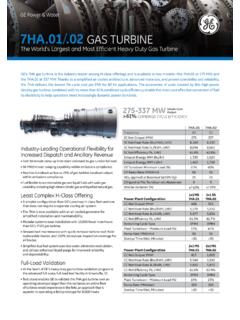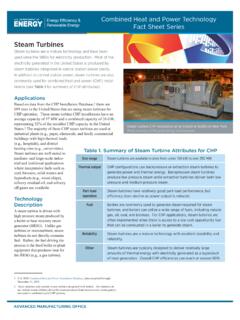Transcription of U.S. Environmental Protection Agency Combined Heat and ...
1 Environmental Protection Agency Combined Heat and Power Partnership September 2017. Disclaimer The information contained in this document is for information purposes only and is gathered from published industry sources. Information about costs, maintenance, operations, or any other performance criteria is by no means representative of EPA, ORNL, or ICF policies, definitions, or determinations for regulatory or compliance purposes. The September 2017 revision incorporated a new section on packaged CHP systems (Section 7). This Guide was prepared by Ken Darrow, Rick Tidball, James Wang and Anne Hampson at ICF. International, with funding from the Environmental Protection Agency and the Department of Energy. Catalog of CHP Technologies ii Disclaimer Table of Contents Section 1.
2 1 1. Overview of CHP 1 2. CHP Efficiency Compared to Separate Heat and Power .. 1-8. 1-10. Comparison of Water Usage for CHP compared to SHP .. 1-12. 1-13. Section 2. Technology Characterization Reciprocating Internal Combustion 2 1. 1. 2. Combined Heat and 2. Emergency/Standby 3. Peak Shaving ..2 3. Technology 2 3. Basic 3. 5. Engine System ..2 5. Diesel Engines ..2 6. Dual Fuel Engines ..2 7. Heat Recovery ..2 8. Performance Characteristics .. 2 9. Part Load 2 11. Effects of Ambient Conditions on 2 12. Engine Speed 2 12. Performance and Efficiency 2 13. Brake Mean Effective Pressure (BMEP) and Engine 2 13. 2 14. Capital 14. 2 16. Fuels .. 2 17. Liquefied Petroleum 2 18. Field Gas .. 2 18. 19. Industrial Waste Gases.
3 2 19. System Availability .. 2 20. Catalog of CHP Technologies iii Table of Contents Table of Contents (continued). Emissions and Emissions Control 20. Emissions Characteristics .. 2 21. Nitrogen Oxides (NOx).. 2 21. Carbon Monoxide (CO) .. 2 21. Unburned 2 22. Carbon Dioxide (CO2).. 2 22. Emissions Control Options .. 2 22. Combustion Process Emissions Control .. 2 22. Post-Combustion Emissions 2 24. Oxidation Catalysts .. 2 24. Diesel Particulate 2 24. Three Way Catalyst (Non Specific Catalytic Reduction) .. 2 24. Selective Catalytic Reduction (SCR).. 2 25. Gas Engine Emissions Treatment 2 25. Future Developments ..2 26. Section 3. Technology Characterization Combustion Turbines .. 3 1. 1. 1. Technology 3 2.
4 Basic 2. 4. Types of Gas Turbines ..3 5. Performance Characteristics .. 3 5. Fuel Supply Pressure ..3 7. Heat Recovery ..3 8. Part-Load Performance ..3 9. Effects of Ambient Conditions on 3 10. Ambient Air 3 10. Site Altitude .. 3 12. Capital 12. 3 14. Fuels ..3 15. Gas Turbine System 3 16. Emissions and Emissions Control 16. 3 16. Emissions Control Options .. 3 17. Catalog of CHP Technologies iv Table of Contents Table of Contents (continued). Diluent 3 18. Lean Premixed Combustion .. 3 18. Selective Catalytic Reduction (SCR).. 3 18. CO Oxidation 3 19. Catalytic 3 19. Catalytic Absorption 3 19. Future Developments ..3 20. Section 4. Technology Characterization Steam 4 1. 1. 2. Technology 4 3. Basic 3. 3. 4. Steam Turbine.
5 4 4. Condensing 6. Non-Condensing (Back-pressure) 7. Extraction 8. Performance Characteristics .. 4 9. Performance Losses .. 4 11. Performance 4 12. Steam Reheat .. 4 12. Combustion Air Preheating .. 4 12. Capital 12. 4 14. Fuels .. 4 15. System Availability .. 4 15. Emissions and Emissions Control 15. Boiler Emissions Control Options - 4 16. Combustion Process emissions 4 16. Flue Gas Recirculation (FGR).. 4 17. Low Excess Air Firing (LAE) .. 4 17. Low Nitrogen Fuel 4 17. Burner 4 17. Water/Steam Injection .. 4 18. Post-Combustion Emissions 4 18. Catalog of CHP Technologies v Table of Contents Table of Contents (continued). Selective Non-Catalytic Reduction (SNCR).. 4 18. Selective Catalytic Reduction (SCR).
6 4 18. Boiler Emissions Control Options SOx .. 4 18. Future Developments ..4 19. Section 5. Technology Characterization Microturbines .. 5 1. 1. 1. Technology 5 2. Basic 2. 3. Turbine & Compressor ..5 3. Generator ..5 4. Recuperator & Combustor ..5 5. CHP Heat 5. Performance Characteristics .. 5 5. Part-Load Performance ..5 7. Effects of Ambient Conditions on 8. Capital Cost .. 5 12. 5 14. Fuels .. 5 16. System Availability .. 5 16. 16. Future Developments ..5 17. Section 6. Technology Characterization Fuel 6 1. 1. 3. Combined Heat and 4. Premium 4. Remote 5. Grid 5. Peak Shaving ..6 5. 6. Technology 6 6. Basic Processes and 6. Fuel Cell 9. Catalog of CHP Technologies vi Table of Contents Table of Contents (continued).
7 Fuel 9. Power Conditioning Subsystem .. 6 10. Types of Fuel 6 10. PEMFC (Proton Exchange Membrane Fuel Cell or Polymer Electrolyte Membrane).. 6 11. PAFC (Phosphoric Acid Fuel Cell) .. 6 11. MCFC (Molten Carbonate Fuel Cell).. 6 12. SOFC (Solid Oxide Fuel Cell) .. 6 12. Performance Characteristics ..6 13. Electrical Efficiency .. 6 14. Part Load 6 14. Effects of Ambient Conditions on 6 15. Heat Recovery .. 6 15. Performance and Efficiency 6 16. Capital Cost .. 6 16. 6 17. Fuels ..6 17. System Availability .. 6 18. Emissions and Emissions Control 18. Primary Emissions 6 18. Nitrogen Oxides (NOx).. 6 18. Carbon Monoxide (CO) .. 6 19. Unburned 6 19. Carbon Dioxide (CO2).. 6 19. Fuel Cell Emission 6 19. Future Developments.
8 6 20. Section 7. Packaged CHP Systems .. 7 1. 1. The Evolution of Packaged CHP Systems .. 7 1. Significant 4. Standardization ..7 4. Black Start/Islanding 4. Acoustic 5. 5. Third-Party Own/Operate Business 6. 6. Catalog of CHP Technologies vii Table of Contents Table of Contents (continued). 6. Installed Packaged Systems ..7 7. Technical Potential ..7 9. Technology 10. Heat Recovery .. 7 11. Cost and Performance 12. Part-Load Operation .. 7 13. Installed Costs .. 7 13. Maintenance Costs .. 7 14. Fuels ..7 15. Emissions, Emissions Control Options, and Prime Mover 15. Appendix A: Expressing CHP Efficiency Catalog of CHP Technologies viii Table of Contents List of Figures Figure 1-1. CHP versus Separate Heat and Power (SHP) Production.
9 1-9. Figure 1-2. Equivalent Separate Heat and Power 1-10. Figure 2-1. 4-Stroke Reciprocating Engine 4. Figure 2-2. Closed-Loop Heat Recovery 9. Figure 2-3. Part Load Generator Terminal Efficiency, System 2 12. Figure 3-1. Gas Turbine Configuration with Heat Recovery ..3 3. Figure 3-2. Components of Simple Cycle Gas 4. Figure 3-3. Heat Recovery from a Gas Turbine System ..3 8. Figure 3-4. Effect of Part Load Operation on Electrical 3 10. Figure 3-5. Effect of Ambient Temperature on Capacity and 3 11. Figure 3-6. The Effect of Altitude on Gas Turbine 3 12. Figure 4-1. Boiler/Steam Turbine 3. Figure 4-2. Comparison of Impulse and Reaction Turbine 5. Figure 4-3. Condensing Steam 7. Figure 4-4. Non-Condensing (Back-pressure) Steam 7.
10 Figure 4-5. Extraction Steam 8. Figure 5-1. Microturbine-based CHP System 3. Figure 5-2. Compact Microturbine 5. Figure 5-3. Part Load Efficiency at ISO Conditions, Capstone 8. Figure 5-4. Temperature Effect on Power, Capstone C200-LP ..5 9. Figure 5-5. Temperature Effect on Efficiency, Capstone C200-LP .. 5 10. Figure 5-6. Temperature Effect on Power and Efficiency, FlexEnergy MT250 .. 5 10. Figure 5-7. Ambient Elevation vs. Temperature Derating, Capstone C65 .. 5 12. Figure 5-8. Capstone C370 Two-shaft High Efficiency Turbine 5 18. Figure 6-1. Commercial Fuel Cell for CHP 4. Figure 6-2. Fuel Cell Electrochemical 7. Figure 6-3. Effect of Operating Temperature on Fuel Cell Efficiency ..6 9. Figure 6-4. Comparison of Part Load Efficiency Derate.














